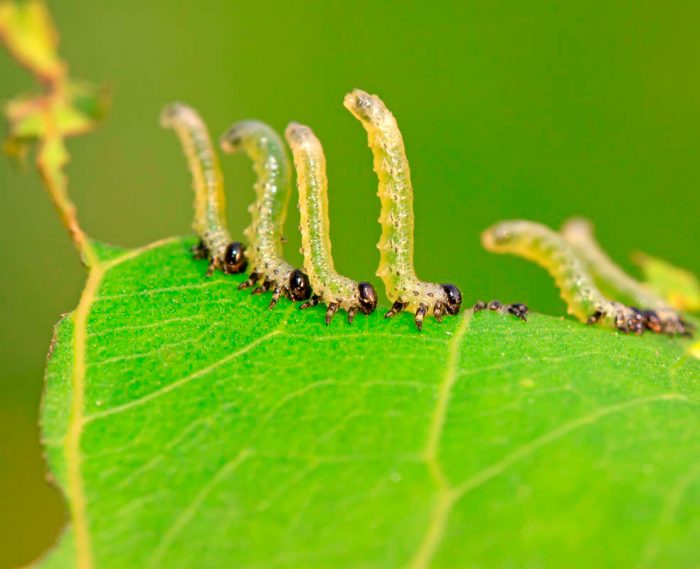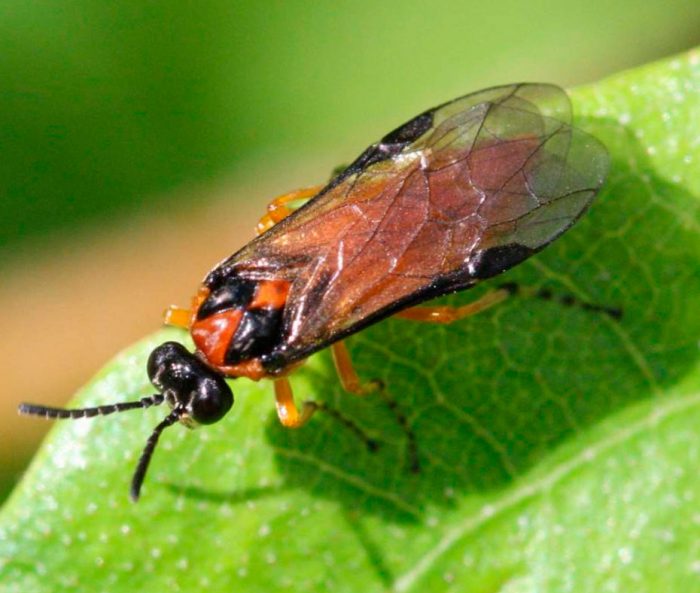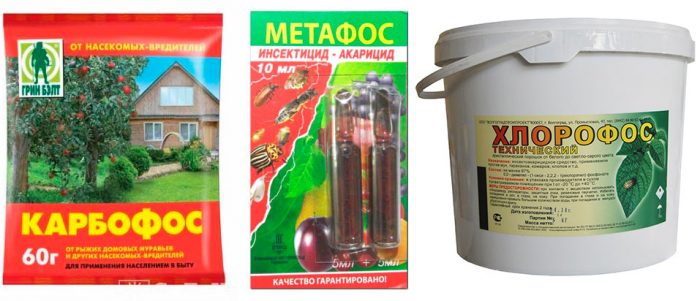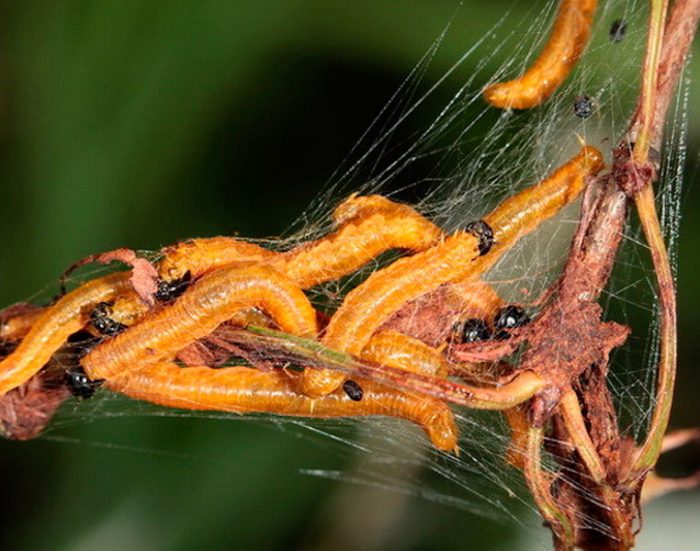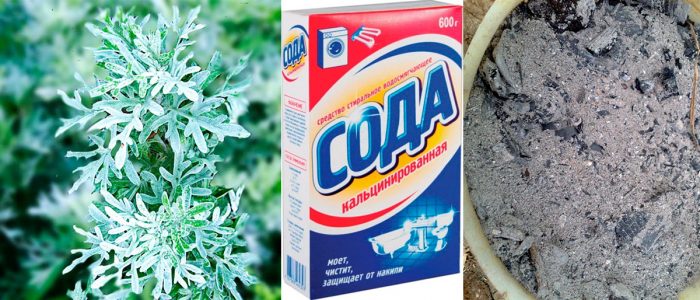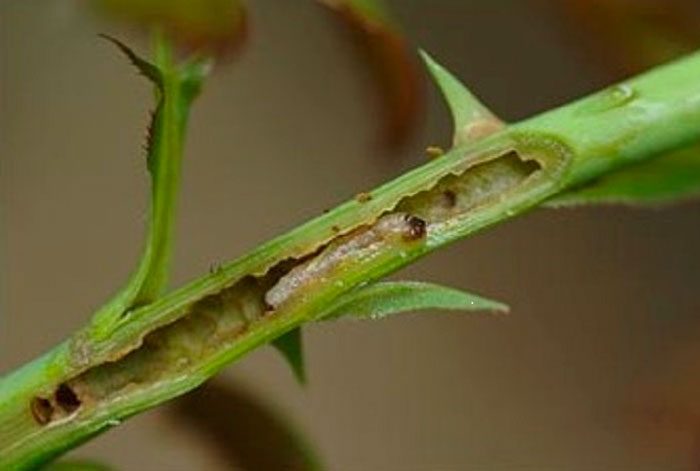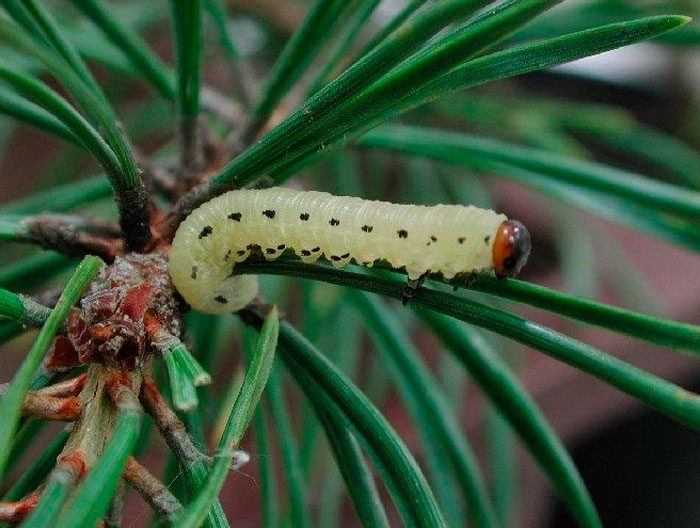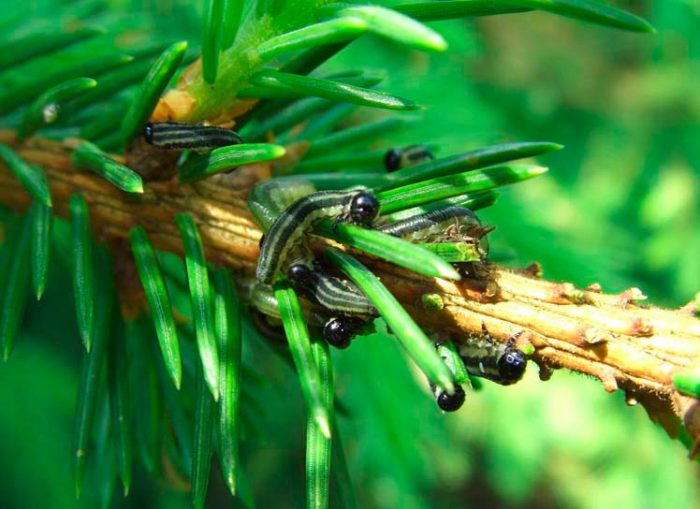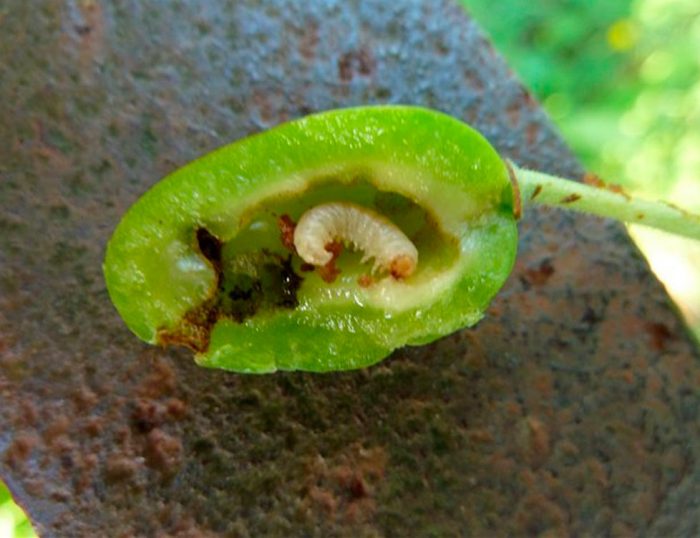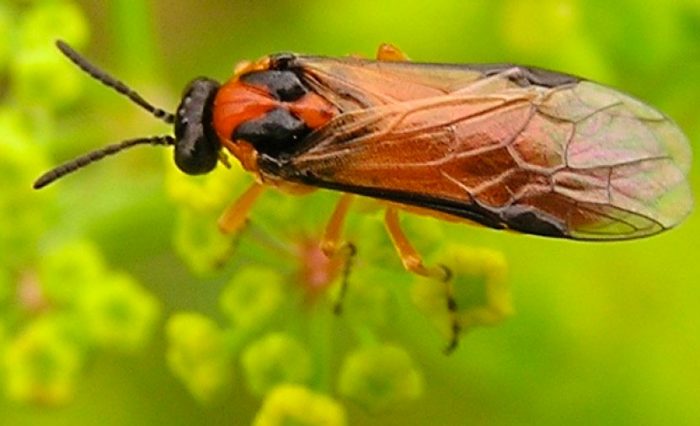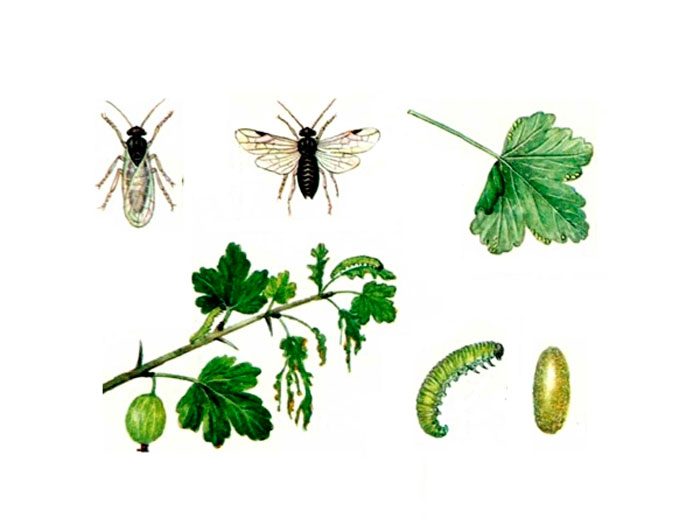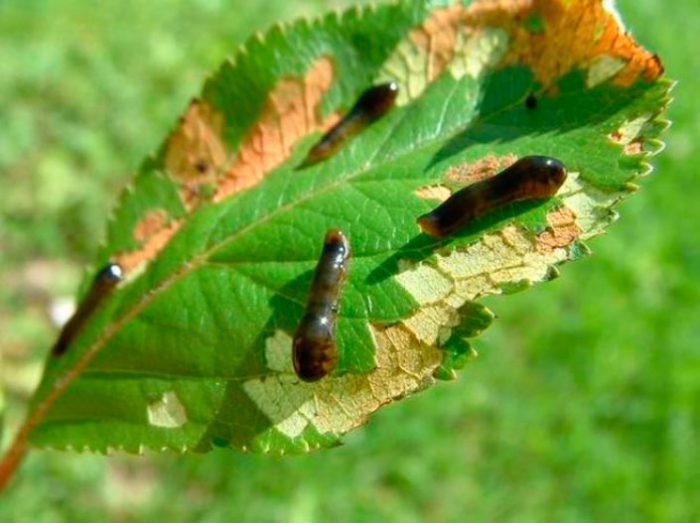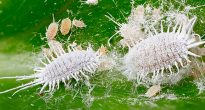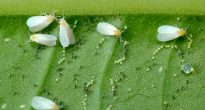True sawflies are a family of hymenoptera, sitting-belly insects, belonging to the group of sawflies. This family unites about 400 genera and more than 5 thousand species. Most of the sawfly species harm crops and forest land. Insects belonging to this family can be found in any corner of the planet Earth, however, most sawfly species live in those countries where the climate is cold and temperate. For example, in Russia there are more than 2 thousand species, while in Finland more than 700 sawfly species can be found. And in South America and Australia, there are very few sawfly species.
Content
Sawfly features
Depending on what species the sawfly insect belongs to, its length varies from 0.2 to 3.2 cm. The body and head of this beetle are not separated from each other (for example, like a bee), therefore it is called sitting-belly. On a mobile large head there are developed jaws, as well as 2 large eyes and 3 simple ones in front. The beetle also has thread-like or bristle whiskers, as well as 2 pairs of non-folding wings, which are completely transparent. In females, a sawtooth ovipositor is hidden in the abdomen, and it is to them that they harm various cultures. Where in females there is a hole for the exit of the ovipositor, in males this place is covered by a plate.
Mating of such beetles is observed in early spring. Then the females arrange egg-laying, for this they cut tissue in various parts of the plant and lay eggs there. After that, the female's pocket with the egg is sealed with her own secretions, which protect this part of the plant and the egg from the appearance of rot. After the larvae emerge from the eggs, they immediately begin to eat, thereby causing great harm to the plants. The sawfly larvae are outwardly similar to the caterpillars of butterflies, but the caterpillars have no more than five pairs of legs and 6 eyes, and the sawfly larvae have 6 or 8 pairs of legs and only 2 eyes. Experts call these larvae false caterpillars.
In the first summer weeks, satiated larvae descend from the plant to the ground and make a cocoon in the soil for pupation from dust, their excrement and saliva. Already in the middle of the summer period, the second generation of sawflies emerges from the cocoons.And in just one season, this insect is able to give up to four generations, which cause significant harm to various plants in spring, summer, and autumn.
All sawfly species are herbivorous. Each of the species prefers to live on one of the cultivated or wild plants. They cause significant harm to the plant by eating its tissues.
How to deal with a sawfly
Sawfly Remedies (preparations)
In order to save a plant from a sawfly, chemicals are often used, or rather, insecticides. The most effective insecticides:
- Karbofos... It is a contact insecticide-acaricide with a broad spectrum of action. It is included in most drugs.
- Benzophosphate... Such an organophosphate insecticide-acaricide is distinguished by its intestinal contact action.
- Metaphos... It is a contact insecticidal preparation with broad spectrum acaricidal properties. Its active ingredient is parathion methide.
- Chlorophos... This insecticide and pesticide of contact-intestinal action is widely used in the fight against harmful insects of various plants.
- Phosphamide... This systemic and contact action acaricide and insecticide is absolutely harmless to warm-blooded animals.
- Arrivo... Such a broad-spectrum insecticidal preparation is distinguished by contact and intestinal action. Cypermethrin is its main active ingredient.
- Virin-Diprion... This viral agent is used to kill pests on all plants, including trees.
- Aktara... This insecticidal agent of the neonicotinoid group is distinguished by its high efficiency against most pests.
- Karate... This entero-contact pyrethroid insect-acaricide is highly effective even with a low consumption of funds. Its active ingredient is lambda-cyhalothrin.
- Confidor... This insecticidal agent of systemic contact-intestinal action is used in the fight against gnawing and sucking pests. The active substance is imidacloprid.
- Mospilan... Systemic insecticidal agent, characterized by contact and intestinal action.
- Kinmix... A broad spectrum pyrethroid insecticide with high efficiency.
- Decis... It is a garden contact-intestinal insecticidal preparation that blocks the digestive system of the pest. The active substance is deltamethrin.
In addition to these funds, many others are used in the fight against sawflies.
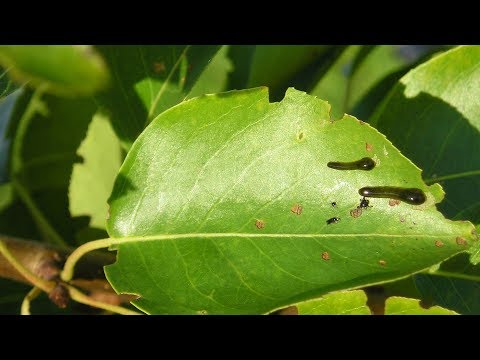

Watch this video on YouTube
Preventive measures
In order to protect your site from sawflies, it is recommended not to forget about preventive measures:
- In the near-trunk circles of shrubs and trees, the surface of the soil must be systematically dug up and loosened. Due to this, quite a few sawfly larvae and pupae will die.
- Dried and diseased trees should not be in the garden, as pupated pests prefer to winter in them.
- Those ovaries that are injured by a beetle should be cut off and destroyed by fire or buried in the soil to a depth of at least half a meter.
- At the beginning of spring, it is recommended to put on trapping belts on tree trunks. You can also use pheromone traps in the fight against the sawfly.
Folk remedies
You can fight the sawfly with various folk remedies:
- At the initial stage of development, in the fight against this pest, you can use an infusion of aconite herb, which must be collected during flowering. To prepare the infusion, you need to combine 1 bucket of water and 1 kilogram of grass, and 30 milligrams of alkali is also poured into the mixture. The product will be ready in 2 days. Before you start spraying the plants, 40 to 50 grams of liquid soap is poured into the product.
- In order to get rid of the larvae of the pest, use chamomile infusion.To do this, a kilogram of crushed foliage and chamomile flowers are poured into a bucket of water, the temperature of which should be from 60 to 70 degrees (the grass is collected during flowering). The infusion will be ready after 12 hours, then it is filtered and diluted with water 1: 1. Add 40 grams of liquid soap to a bucket of prepared solution.
- 1.2 kg of fresh wormwood herb is dried, and then mixed with 1 bucket of water. The infusion will be ready in 3 days. Then add 50 to 100 grams of baking soda to the strained product.
- 10 liters of water is combined with two kilograms of needles. Every day the mixture is stirred for one week, all this time it should be in a dark place. The strained infusion should be diluted with water in a ratio of 1: 3 or 1: 5.
- One bucket of water is combined with 70 grams of soda ash and 20 grams of liquid soap.
- A bucket of hot water is mixed with three kilograms of sifted wood ash. The infusion will be ready in 2 days, it is filtered through a fine sieve or gauze. Before processing, 40 grams of liquid soap is poured into it.
- One bucket of water is combined with a kilogram of fresh tansy. The mixture is boiled for two hours and allowed to cool down. 40 grams of liquid soap is poured into the strained product.
It is recommended to use folk remedies only when there are very few sawflies. But most summer residents use them only as a means of prevention.
Sawfly species
There are many types of sawflies that can harm cultivated plants. Therefore, below will be described only those of them that are most common.
Sawfly on roses
Roses can be harmed by several types of sawfly, which are divided into a couple of groups:
- openly living on plants and eating leaves, for example: rosaceous, rosaceous changeable, rosaceous slimy, rosaceous common, black and cherry slimy sawflies;
- living hidden and eating stems from the inside, for example: rose-like ascending and rose-like descending sawflies (they cause great harm to flowers).
In the event that there are not very many pests, then the collection of their larvae is carried out manually, after which they should be burned. It is recommended to collect the larvae in the early morning, since it is at this time that they are clearly distinguishable on the surface of the foliage. Insecticidal preparations are used only if there are too many openly living pests on the bushes, for example, it is suitable: Confidor, Fastaka, Decis, Aktara or Karate. In order to reduce the number of cocoons, the soil around the roses should be systematically dug up.
To get rid of hidden sawflies, it is recommended to use systemic insecticidal preparations, for example, treatment can be carried out with Mospilan, Angio or Aktara. In order to get rid of the pest, you need to process the bushes at least 2 times with a break of 3 weeks, while before processing all injured stems are cut and destroyed.


Watch this video on YouTube
Pine sawfly
The pine sawfly can be found where there are conifers. The fact is that such a pest feeds on needles. This harmful insect is widespread in Asian and Caucasian countries, in Russia and Japan, and it was also brought to North America. This species cannot be found only in the Arctic. There are only 2 types of pine sawflies, namely: red pine and common pine sawfly. The common sawfly is much more common than the second species.
In early spring, pests eat old needles, and then begin to damage young shoots. In this case, sawflies damage both the needles and the branches themselves. Banks pine and Scots pine are most often damaged by the pest. In warm and dry weather, pine sawflies are most voracious.
In addition to these types of pests, pine star sawfly-weaver, which is widespread in Europe, as well as in Kazakhstan and Siberia, can still settle on pine. The length of this insect varies from 1 to 1.6 cm. Its wings are transparent, and the chest and head are painted black, while they are covered with streaks of white and yellow. The larva reaches a length of 1.8 to 2.6 cm, it is painted in an olive green hue, and on its surface there are 4 brown stripes. She has no abdominal legs, but there are 3 pairs of sternum legs, with the help of which she moves. This species is also called "weaver", because its larvae make caches of cobwebs in the form of a tube. Such a sawfly damages young needles, and if a lot of pests have settled on the plant, then the upper parts of the branches can also be injured, and in rare cases, this leads to the death of a whole tree. In order to get rid of such a harmful insect, insecticidal agents and glue belts are most often used. In the event that the sawfly is found in a large area of forest land, then the trees are processed using aircraft.
Spruce sawfly
A spruce sawfly can settle on spruce trees, which actively eats young needles of the current year. This pest causes the greatest harm to plants from the last days of May to the first - June. If the winter is warm, then there is an outbreak of the sawfly's fertility, for example, it produces a lot of caterpillars for 5-7 years.
To find out if the sawfly has settled on your spruce, examine it. If you find a lot of injured or eaten needles, then this indicates that the larvae of this pest are present on the tree. Control methods:
- manual collection of sawfly larvae;
- attracting ants, birds and rodents to the site;
- installation of sticky plates on trees;
- regular digging of the near-stem circle (allows you to destroy pupae);
- regular collection and destruction of flying needles;
- when caterpillars are found, the plant is sprayed with Karbofos or Kinmiks.
Plum sawfly
Sawflies can also settle on the plum. As a rule, mainly 2 species harm this tree, namely, black and yellow plum sawfly. These species are similar to each other and differ in almost only one color. The length of an adult is up to 0.5 cm, and the larvae are about 0.8 cm. In addition to the wings of a light color with a brown stigma, all other parts of the body are black in the black sawfly. In this case, the yellow sawfly is painted in a brownish yellow tint. Only one larva can damage about six plum fruits, so if there are a lot of sawflies on the tree, then the gardener may be left without a crop.
In the fight against the pest, even before the tree blooms, it is treated with a solution of Rogor, Cyanox, Chlorophos, Karbofos or Cydial. When the plum has faded, re-spraying is carried out. At the beginning of the spring period, even before the pests leave their cocoons, in order to scare them away, it is recommended to treat the plant with a coniferous infusion diluted with water or an infusion of wormwood. Before the flowers on the plum open, on a cloudy day, tissue is spread under it, on which adult beetles are shaken off the plant. After that, they are destroyed by fire. Those larvae that have settled down for wintering in the ground can be destroyed, for this it is enough to dig up the ground in the near-trunk circle, and they do it in the fall.


Watch this video on YouTube
Rapeseed sawfly
Plants belonging to the Cruciferous family can be damaged by the rape sawfly. Most often, this species is found in regions with cool and temperate climates. Its larva, painted in a gray-green hue, has 11 pairs of legs, the shape of which is cylindrical; small warts are present on the surface of the body. In length, the larva can reach from 2 to 2.5 cm, but after pupation, a decrease in length to 0.6–1.1 cm is observed.The length of an adult sawfly is about 0.6-0.8 cm, and its color is orange-yellow, its head is lacquered black, and there are diamond-shaped specks on its back.
Although this pest has a small size, it has a very high harmfulness threshold. So, if only 2 or 3 larvae settle on 1 square meter of the plot, then they can cause significant damage to crops. It is believed that this sawfly is the most dangerous in the forest-steppe zones of Ukraine, Moldova and the European part of Russia. It eats foliage and stems of crops such as radish, rapeseed, rutabaga, turnip, cabbage, turnip, mustard, daikon and radish. First of all, the harmful insect eats foliage, buds and young pods. Bushes injured by the sawfly do not form fruit, as a result, you can lose from 80 to 95 percent of the harvest of rapeseed or turnip.
To get rid of this pest, if 10 percent of the stems are affected or more, the bushes are sprayed with an insecticidal solution. There are also preventive measures: timely weeding, deep loosening of the soil, removal of plant residues from the site after harvesting (it is recommended to burn them), compliance with the rules of crop rotation. They also sometimes make bait crops, which after a while are destroyed along with the sawflies.
Gooseberry sawfly
The yellow gooseberry sawfly damages crops such as red and white currants, and also gooseberries. The length of such a flying beetle is about 10 mm, it has a yellow-red color, its legs are yellow, and its head is black. Shrubs are harmed by the larvae of this insect. They are greenish-blue, there are hairs and many black warts on the surface of their body, they have 10 pairs of legs. They devour foliage and gnaw out buds for 20-30 days. If the summer period is warm and long, then this pest will be able to give 3 generations within one season. The second generation harms plants the most, because the activity of pests at this time occurs just at the period when the fruits are actively poured and ripen.
The pale-footed gooseberry sawfly causes serious harm to the foliage of these shrubs, its larvae devour the foliage, and only one vein remains from it. The larvae of this species are colored green, have ten pairs of legs and a brown head, they are distinguished by their gluttony.
As soon as pests are noticed on the bush, urgent measures must be taken. In the event that more than half of the foliage is preserved on the damaged shrub, then the use of insecticidal preparations is not recommended. In this case, manual collection of the larvae will be required, if desired, they can be shaken off onto a cloth, which is previously spread under the bush. Then the larvae are destroyed. After that, the bush is sprayed with a folk remedy that contains a large amount of bitterness, for example: infusion of garlic, wormwood, tobacco, tansy or yarrow. Ash infusion is also quite effective in the fight against sawflies. In order to scare off adults from the bushes, it is recommended to grow tomatoes between the plants. When the crop is harvested, spray the plant with a biological product that strengthens the shrub's immunity. Throughout the summer, systematically loosen the ground between the bushes and remove weeds in a timely manner. In autumn, be sure to dig up the soil near the bushes. The treatment of gooseberries and currants with insecticidal preparations is recommended in extreme cases, when there are a lot of larvae on the plant and less than half of the untouched foliage remains.
Cherry sawfly
On cherries, pale-footed and slimy cherry sawflies can settle. The slimy cherry sawfly can also harm pear, plum, cherry, apple and rose.An adult male is 4 to 5 centimeters long and a female is 5 to 6 centimeters long. There is black venation on the transparent wings, and the body and legs of the pest are painted black. Adult sawflies can appear on cherries from the last days of May to mid-June. On the second or third day, the female already begins to lay eggs, the appearance of larvae from them occurs after 7-15 days. On the surface of the larvae that appear, black mucus is formed; during their existence, they molt 5 times. Cherry foliage, which was injured by these larvae, looks like burnt. When the caterpillars are free of mucus for the last time, they turn yellow and rush to the soil surface, where they pupate. In the second generation, the beginning of summer for adult insects occurs in the second half of July.
The pale-footed cherry sawfly can also harm thorns, mountain ash, pear, cherries and various berry bushes. The length of its black body reaches 0.5–1.1 cm, the legs are yellowish, there are black legs on the back pair. The larva has a whitish or greenish color, the head is pale brown, and there is a dark spot on the crown.
If there are a lot of larvae on the cherry, then it is sprayed with a suitable insecticide. If there are few sawflies, then they are manually collected, and they can also be shaken off onto a cloth spread under a tree. The collected larvae are destroyed by fire. Systematically loosen the soil in the near-trunk circle, and in the springtime, dig it up.
In addition to these species, gardeners and gardeners can quite often meet on their site such as: a pear sawfly-weaver, a pear cut sawfly, a slimy sawfly, an ash sawfly, apple fruit and leaf sawflies, a grain sawfly and a black bread sawfly, a stone fruit sawfly and a yellow fruit sawfly dr.


Watch this video on YouTube

